There are no secrets in the tightly packed lanes of Dharavi, India’s largest slum. Everyone knows when an alcoholic husband turns violent, when children are scolded, or when a family has its television turned up too loud.
So, news that someone had been hospitalized with the new coronavirus rocketed through the 1 square mile (2.5 square kilometers) that is home to around a million of Mumbai’s poorest residents.
Born and bred in Dharavi, Kunal Kanase watched authorities ignore everyday disasters, like overflowing sewers and domestic violence. He knew better than to wait for help.
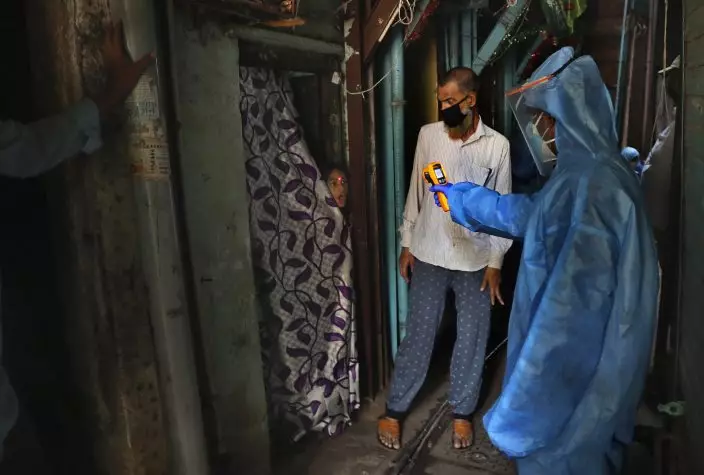
FILE - In this Monday, April 13, 2020, file photo, a doctor checks the temperature of a girl in Dharavi, one of Asia's largest slums, during lockdown to prevent the spread of the new coronavirus in Mumbai, India. Dharavi has had more than 1,800 confirmed COVID-19 cases, and is among Mumbai’s most affected pockets. Set between busy train tracks and the heavily polluted Mithi River, which separates the slum from Mumbai’s modern skyscrapers, the neighborhood is a maze of tiny alleys, each one full of scores of people, many who live in tin shacks. (AP PhotoRafiq Maqbool, file)
The 31-year-old student and community activist hounded government helplines trying to get authorities to quarantine the neighbor's family. Unable to get through, he tweeted at the Mumbai police, who quickly came to take the man's family to a quarantine center.
“I used to teach his two children and felt good for the family since they were relatively safer now,” he said from the tiny two-room apartment he shares with his parents and younger brother.
Kanase is among many unsung heroes working to protect some of India’s most vulnerable people from the ravages of the coronavirus and the economically devastating nationwide lockdown that has left millions unable to feed themselves.
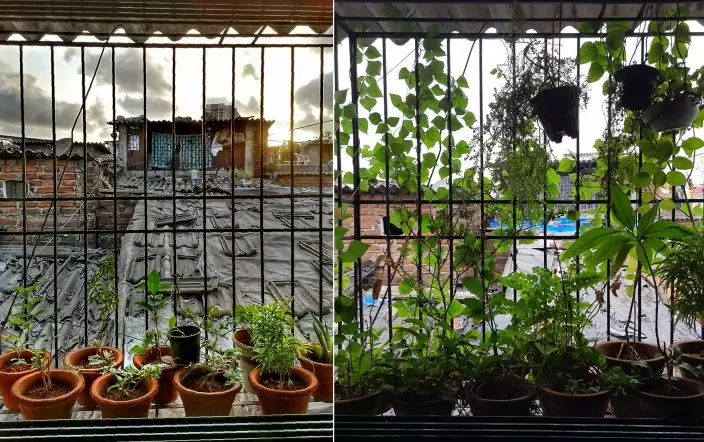
This combination photo shows the container garden built by community activist Kunal Kanase, 31, when he first began it in May 23, 2019, left, and the garden as it stands on Tuesday, June 2, 2020 at his home in Dharavi, one of Asia's largest slums, in Mumbai, India, Saturday, May 16, 2020. Kanase says the people in Dharavi "do not have the privilege to connect with nature. All around Dharavi, you will see only people and houses." So he built the container garden with the help of a friend, especially for his mother who spends a lot of her inside the house. (Kunal Kanase via AP)
When a woman who lives just two houses — less than 10 feet (3 meters) away — from Kanase became sick with COVID-19, he once again tried to notify authorities. He was unsuccessful and no one ever came to test or isolate the six other members of the woman's household.
Kanase would watch as health workers scrambled to stem the outbreak, suiting up to disinfect the squalid lanes and flying drones over the shantytown to surveil people’s movements.
Dharavi has had more than 1,800 confirmed COVID-19 cases, and is among Mumbai’s most affected pockets.
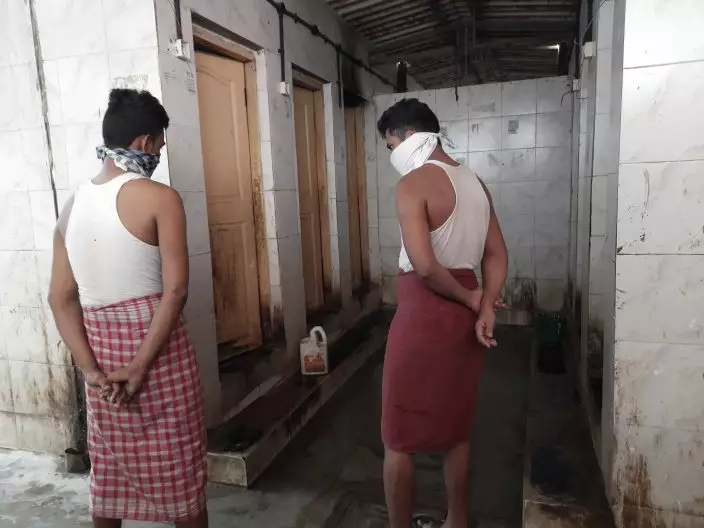
Residents wait in a queue to use a toilet complex in Dharavi, one of Asia's largest slums, in Mumbai, India, Tuesday, May 12, 2020. Dharavi has around 500 toilet complexes for almost a million residents, few having running water. Keeping the toilets disinfected has been a challenge for authorities in the days of the coronavirus. (Kunal Kanase via AP)
The caseload in the city known for Bollywood and the country’s most important stock exchange stood at more than 41,000 on Thursday, and has overwhelmed the under-funded health system.
Mumbai and elsewhere in Maharashtra state in central India account for the largest share of the country’s more than 210,000 confirmed infections , of which more than 104,000 have recovered. India has recorded about 6,000 deaths.
The rate of infection and the loss of life have been relatively small compared to the United States, United Kingdom and other hard-hit countries. But epidemiologists say India is still weeks away from peak coronavirus transmission.
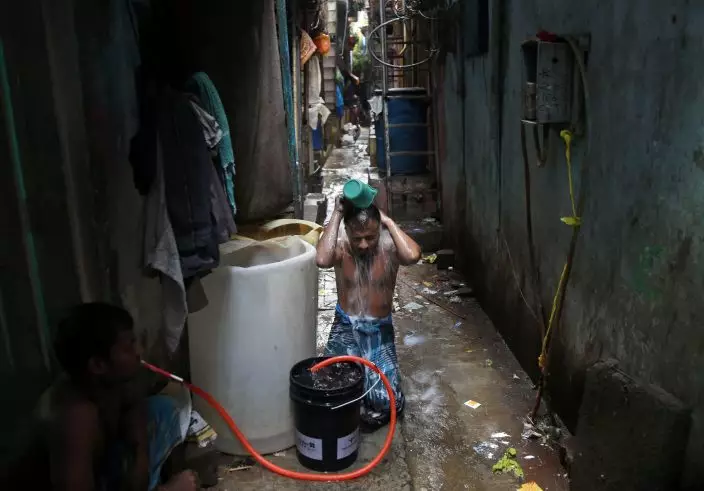
FILE - In this Thursday, July 10, 2014, file photo, a man bathes outside his house in Dharavi, one of Asia's largest slums, in Mumbai, India. Set between busy train tracks and the heavily polluted Mithi River, which separates the slum from Mumbai’s modern skyscrapers, the neighborhood is a maze of tiny alleys, each one full of scores of people who live in tin shacks. Families or groups of migrant workers often pile into a single room. Hardly anyone has a private bathroom. (AP PhotoRafiq Maqbool, File)
Dharavi is known to the world as the setting of the 2008 Oscar-winning film “Slumdog Millionaire." Set between busy train tracks and the heavily polluted Mithi River, which separates the slum from Mumbai’s modern skyscrapers, the neighborhood is a maze of tiny alleys, each one full of scores of people, many living in tin shacks. Families or groups of migrant workers often pile into a single room. Hardly anyone has a private bathroom.
Without reliable running water, the most worrying concern is sanitation. The neighborhood was able to avoid another disaster this week when it was spared damage from a cyclone that hit the city.
Kiran Dighavkar, a Mumbai official who is overseeing medical workers and volunteers in Dharavi, said his staff is focused on cleaning the neighborhood's 500 toilet complexes. Each is visited by at least 1,000 people a day.
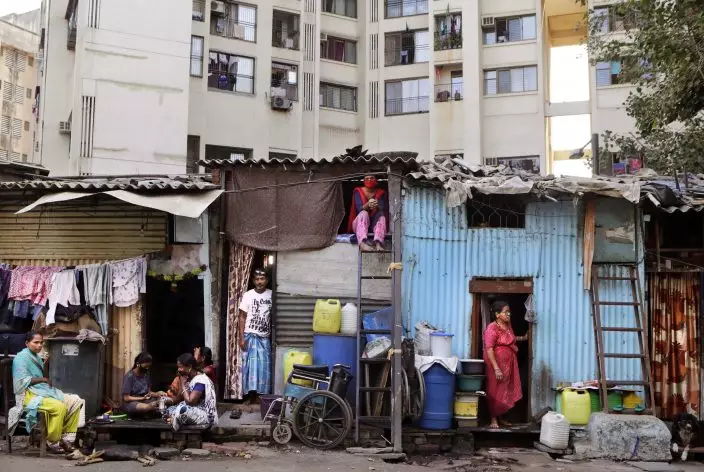
FILE - In this Friday, April 3, 2020, file photo, people rest by their shanties at Dharavi, one of Asia's largest slums, during lockdown to prevent the spread of the coronavirus in Mumbai, India. Dharavi has had more than 1,800 confirmed COVID-19 cases, and is among Mumbai’s most affected pockets. The caseload in the city known for Bollywood and the country’s most important stock exchange passed 38,000 on Monday, and has overwhelmed the under-funded health system. (AP PhotoRajanish Kakade, File)
“These people have to come out twice a day, for food and to use the toilets. So you can imagine how tough it is to practice social distancing,” Dighavkar said.
Kanase and his team at Dharavi Diary, a group of young leaders who work to improve conditions in the slum, have been working to help those affected by the pandemic, handing out bags of rice, flour, cooking oil and sugar — enough to feed a family for two weeks. But they lack the resources to provide for everyone and often must filter out the needy from the neediest.
Each day the slum's poorest — often migrant workers originally from elsewhere in the country — line the main street waiting for food handouts from Dharavi Diary and other volunteers, groups and government agencies.
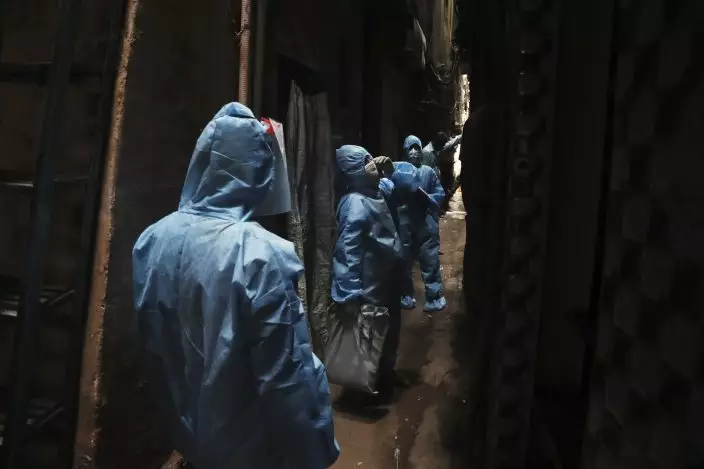
FILE - In this Monday, April 13, 2020, file photo, health workers call out to people to check their body temperatures in Dharavi, one of Asia's largest slums, during lockdown to prevent the spread of the new coronavirus in Mumbai, India. Dharavi has had more than 1,800 confirmed COVID-19 cases, and is among Mumbai’s most affected pockets. The caseload in the city known for Bollywood and the country’s most important stock exchange stood at more than 41,000 on Thursday, and has overwhelmed the under-funded health system. (AP PhotoRafiq Maqbool, File)
India's poor — in Dharavi and the rest of India — have born the brunt of the nationwide lockdown, which finally began to ease this week. Many migrant workers fled cities for their native villages in the countryside rather than risk starvation, sometimes walking for hundreds of miles (kilometers).
For Kanase, the pandemic has highlighted how even in hardship this tightly knit community can come together to aid each other.
“I live in Dharavi and I am proud of it,” he said.
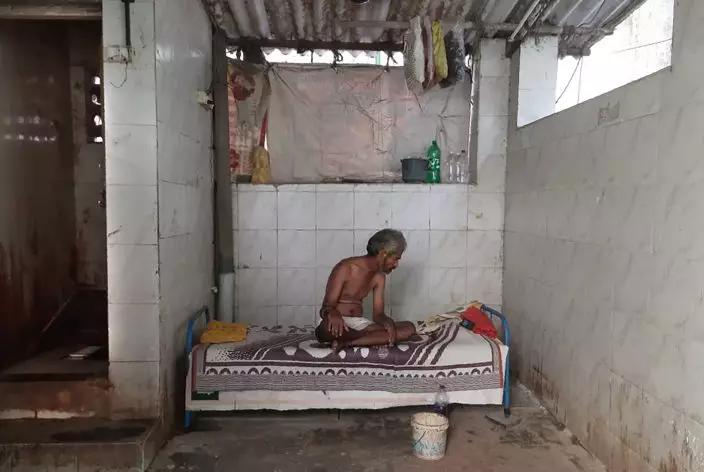
Raja Kadam rests on his bed inside a toilet complex in Dharavi, one of Asia's largest slums, in Mumbai, India, Saturday, May 16, 2020. Kadam, who has lived in this toilet complex for nine years, says toilets here are disinfected once daily. Dharavi has had more than 1,800 confirmed COVID-19 cases, and is among Mumbai’s most affected pockets. Without reliable running water in it's 500 toilet complexes, one of the most worrying concern for authorities is sanitation. (Kunal Kanase via AP)
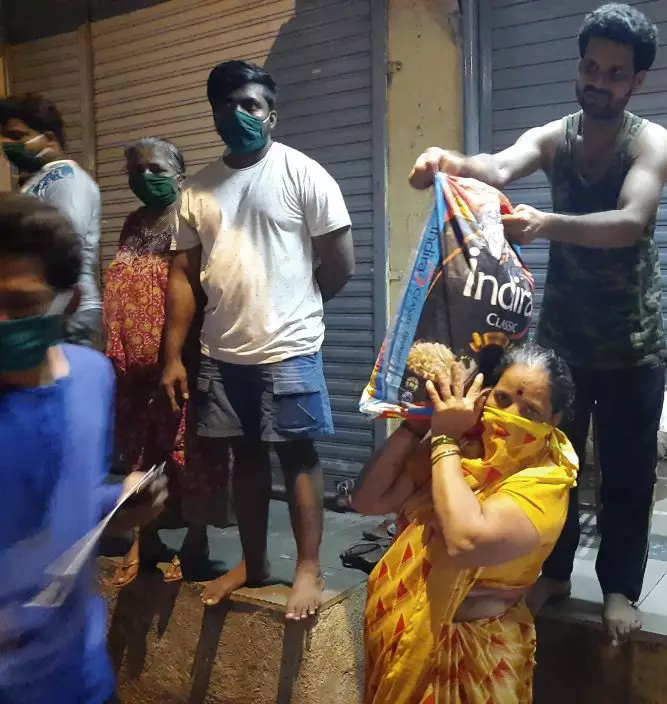
In this Wednesday, May 6, 2020, photo, members of Dharavi Diary distribute food to the needy during lockdown in Dharavi, one of Asia's largest slums, in Mumbai, India. The team at Dharavi Diary, a group of young leaders who work to improve conditions in the slum, have been working to help those affected by the pandemic, handing out bags of rice, flour, cooking oil and sugar — enough to feed a family for two weeks. Dharavi is a 1 square mile (2.5 square kilometers) slum that is home to around a million of Mumbai’s poorest residents. (Kunal Kanase via AP)
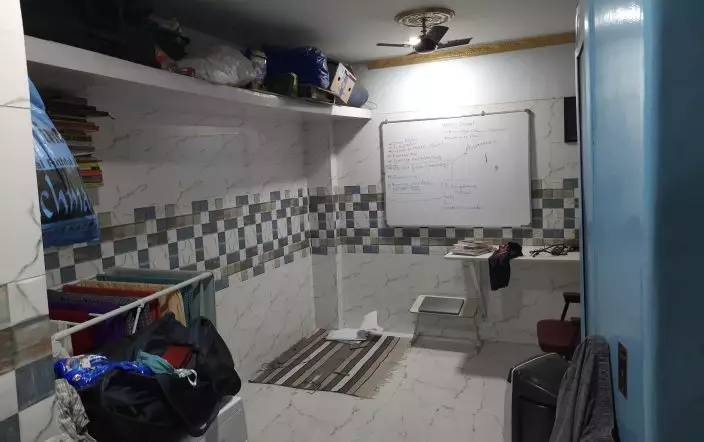
A whiteboard with brainstorming notes on tackling the coronavirus pandemic stand in the home of community activist Kunal Kanase, 31, in Dharavi, one of Asia's largest slums, in Mumbai, India, Sunday, May 10, 2020. Kanase is among many unsung heroes working to protect some of India’s most vulnerable people from the ravages of the coronavirus and the economically devastating nationwide lockdown that has left millions unable to feed themselves. (Kunal Kanase via AP)
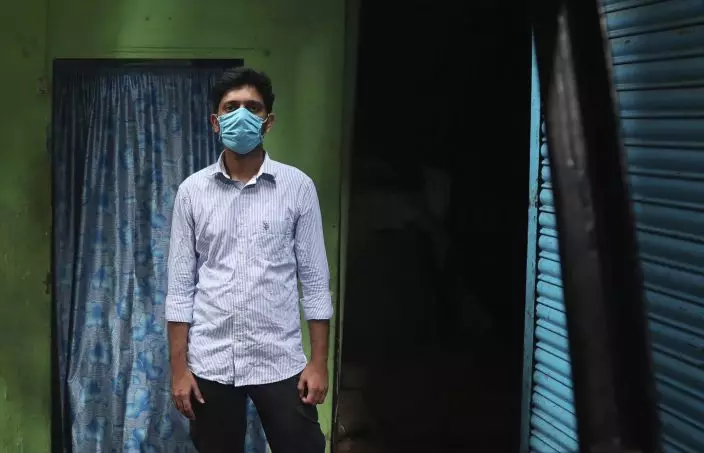
Community activist Kunal Kanase, 31, stands for a picture in a lane of Dharavi, one of Asia's largest slums, in Mumbai, India, Saturday, May 16, 2020. Kanase is among many unsung heroes working to protect some of India’s most vulnerable people from the ravages of the coronavirus and the economically devastating nationwide lockdown that has left millions unable to feed themselves. (AP PhotoRafiq Maqbool)
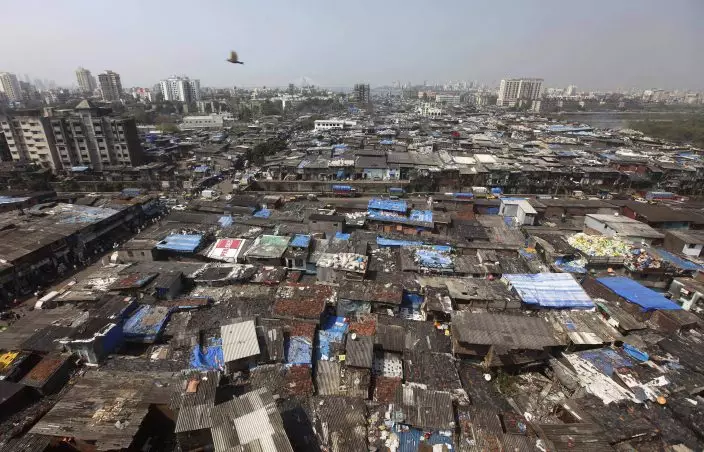
FILE - In this Oct. 27, 2010 file photo, a bird flies over Dharavi, one of Asia's largest slum, in Mumbai, India. Dharavi has had more than 1,800 confirmed COVID-19 cases, and is among Mumbai’s most affected pockets. The caseload in the city known for Bollywood and the country’s most important stock exchange stood at more than 41,000 on Thursday, and has overwhelmed the under-funded health system. (AP PhotoRafiq Maqbool, File)


